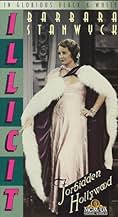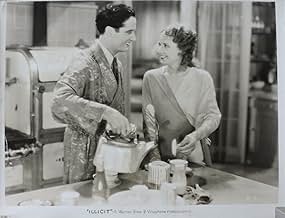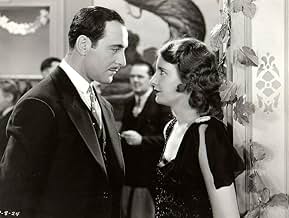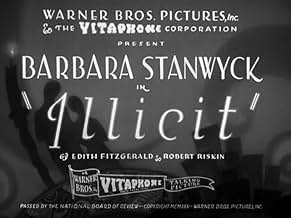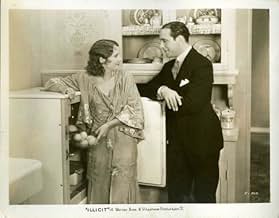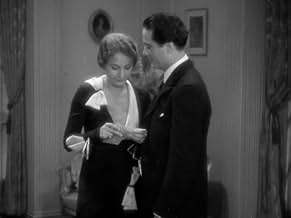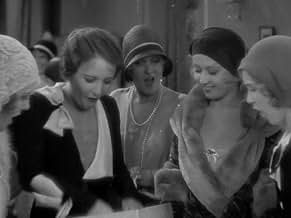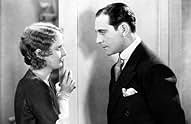NOTE IMDb
6,1/10
1,3 k
MA NOTE
Ajouter une intrigue dans votre langueA young couple lives together out of wedlock, but they find that they're ahead of their time.A young couple lives together out of wedlock, but they find that they're ahead of their time.A young couple lives together out of wedlock, but they find that they're ahead of their time.
- Réalisation
- Scénario
- Casting principal
- Récompenses
- 2 victoires au total
Hazel Howell
- Girl at the Bridal Shower
- (non crédité)
Lucille Ward
- Susan - Anne's Maid
- (non crédité)
Barbara Weeks
- Girl at the Bridal Shower
- (non crédité)
Avis à la une
The naming of this film must have been just to attract Depression era audiences, because there is nothing really illicit about it. However, it is a very modern look at romance and marriage considering it was made in 1931. Barbara Stanwyck plays Anne Vincent, a modern woman who is afraid that her relationship with boyfriend Richard Ives will be changed by marriage. She bases her beliefs on watching her own parents and her friends. In her parents' case she says that she knows they loved each other, but divorced anyways, and she is sure that separation from one another is what killed them. However, social pressures prevail and the two do get married.
Anne's fears become realized as Richard seems to only be interested in going out when it involves other people, not just Anne. She sees him out with another woman one night when he is supposed to be working, and she decides what the two need is a trial separation from one another - to become individuals again. Throw Ricardo Cortez into the mix as someone who wants Anne's marriage to not work out, and you have the makings of an above average potboiler from the precode era.
This film is mainly interesting because of Stanwyck. Without her abilities this would be a pretty forgettable film. And those fashions! With all of the ermine and feathers, this film has Barbara Stanwyck venturing into Kay Francis territory. Also lending good support is Charles Butterworth as the seldom sober friend to the young couple, and the always wonderful Joan Blondell as Anne's close friend.
Anne's fears become realized as Richard seems to only be interested in going out when it involves other people, not just Anne. She sees him out with another woman one night when he is supposed to be working, and she decides what the two need is a trial separation from one another - to become individuals again. Throw Ricardo Cortez into the mix as someone who wants Anne's marriage to not work out, and you have the makings of an above average potboiler from the precode era.
This film is mainly interesting because of Stanwyck. Without her abilities this would be a pretty forgettable film. And those fashions! With all of the ermine and feathers, this film has Barbara Stanwyck venturing into Kay Francis territory. Also lending good support is Charles Butterworth as the seldom sober friend to the young couple, and the always wonderful Joan Blondell as Anne's close friend.
Prohibition; scorned women, that was the early 30's. This was before the "decency" rules came into effect. Avant garde is the only way to describe this. Dated, yes. But very descriptive of the times. Only Stanwyck could do this well. Her strength and sensitivity are evident in every frame. This is a history lesson of the times and traditions that existed way back when!
In 1931, Stanwyck was still a young girl, with her LONG hair, child-like innocent manner, and round kid face. As Anne Vincent, she wants to stay single and happy, while her beau Dick (James Rennie) wants to get married. Along for fun is Charles Butterworth as George, Dick's sidekick. He tells the couple that they have been discovered, and totters off, for more drinks... Ricardo Cortez is also here as the ex-boyfriend Baines to stir things up; Stanwyck and Cortez had worked together on three films together in the 1930s. Look for a 25 year old Joan Blondell as Helen Childers, Anne's friend, in one of her early roles. Will things stay the same if they get married? That's the big question. Kind of a statement of the times, and even more so in a couple years when the production code will keep everything on the up and up, even when they aren't. This was Darryl Zanuck's 12th film as producer. Towards the middle of the version shown on Turner Classics, there are scratches or wear marks on the right side of the screen, not surprising for such an old film. Interesting to watch, but no big surprises.
The plot of "Illicit" is similar to the plot of an early Bette Davis film called "Ex-Lady" made two years after this one. They should be similar - Edith Fitzgerald wrote both of them. "Ex-Lady" was based on an unproduced play, and "Illicit" actually was a play. Both concern women who don't want to get married and men who do. Anne (Stanwyck)(like Davis) is an unconventional free spirit afraid that marriage will destroy the romance she has with Dick (James Rennie). However, word gets around that the two have been weekending in Connecticut, and Dick's father (Claude Gillingwater) convinces her to agree to marry Dick. Thanks to an old girlfriend of Dick's and an old beau of Anne's, trouble brews in paradise once the rings are exchanged.
This is an early sound film, so the rhythm is off, and some of the sound has an echo. However, a few pauses that are a little too long don't really impede the fine acting. Stanwyck is wonderful and gives indication of the wonderful star she will become. She's funny, vivacious, and likable. Charles Butterworth plays a drunken friend very convincingly, and Claude Gillingwater is dignified yet warm as Dick's father. Rennie makes an attractive lover turned husband for Stanwyck. Joan Blondell has a small role as a friend.
The film is interesting because it's early Stanwyck, but also because of the independent woman angle which soon will fade from view with the ushering in of the code. Once the '40s hit, the independent woman became an uptight career woman wearing a tailored suit, her hair up, and sporting a stern attitude. Young, carefree non-virgins became a thing of the past. But these precode films are what helped mold the strong images of Katharine Hepburn, Bette Davis, and Barbara Stanwyck and are worth watching.
This is an early sound film, so the rhythm is off, and some of the sound has an echo. However, a few pauses that are a little too long don't really impede the fine acting. Stanwyck is wonderful and gives indication of the wonderful star she will become. She's funny, vivacious, and likable. Charles Butterworth plays a drunken friend very convincingly, and Claude Gillingwater is dignified yet warm as Dick's father. Rennie makes an attractive lover turned husband for Stanwyck. Joan Blondell has a small role as a friend.
The film is interesting because it's early Stanwyck, but also because of the independent woman angle which soon will fade from view with the ushering in of the code. Once the '40s hit, the independent woman became an uptight career woman wearing a tailored suit, her hair up, and sporting a stern attitude. Young, carefree non-virgins became a thing of the past. But these precode films are what helped mold the strong images of Katharine Hepburn, Bette Davis, and Barbara Stanwyck and are worth watching.
The best part of this rather boring gabfest is getting to see ladies high-fashion outfits, circa 1930. Some of them are real doozies. Stanwyck gets more than her share of slinky finery as a rich guy's paramour. Actually, the movie's premise is a significant one—does marriage somehow kill love? Anne (Stanwyck) seems to think so and sometimes acts on the premise. The trouble is that the premise gets drowned out by all the talk from one scene to the next, without let-up. Then too, director Mayo adds nothing to what turns out to be a filmed stage play. To be charitable, his options may have been cramped by the newness of movie sound equipment.
Pre-Code liberties are evident in the first few scenes where Anne, in a clinging negligee, and Dick (Rennie) discuss whether to marry or to continue living in sin. After that, the screenplay settles into more conventional marital mix-ups. But at least Stanwyck shines, showing why she was slated for bigger and better things. In fact, she's almost girlish, a really long way from the femme fatale of Double Indemnity (1944). Too bad she doesn't have more scenes with that other Warner's personality girl, Joan Blondell (Duckie). Anyway, I found the movie considerably less than I expected.
Pre-Code liberties are evident in the first few scenes where Anne, in a clinging negligee, and Dick (Rennie) discuss whether to marry or to continue living in sin. After that, the screenplay settles into more conventional marital mix-ups. But at least Stanwyck shines, showing why she was slated for bigger and better things. In fact, she's almost girlish, a really long way from the femme fatale of Double Indemnity (1944). Too bad she doesn't have more scenes with that other Warner's personality girl, Joan Blondell (Duckie). Anyway, I found the movie considerably less than I expected.
Le saviez-vous
- AnecdotesOn the phone, Dick and Anne tease Duckie that they can't agree on which vacuum cleaner to buy, a Peerless or a General Electric. The joke here appears to be that Peerless was an old maker of hand-pump vacuums, never electric ones.
- Gaffes(at around 5 mins) As Dick and Anne are walking out of the kitchen, a moving shadow of the boom microphone is visible on the wall to the left.
- Citations
Richard 'Dick' Ives II: Dad, what would you do with a girl like that?
Richard Ives Sr.: I'd grab her any way she'd have me.
- ConnexionsFeatured in Sex, Censorship and the Silver Screen: The Temptations of Eve (1996)
- Bandes originalesMaybe It's Love
(1930) (uncredited)
Music by George W. Meyer
Lyrics by Sidney D. Mitchell and Archie Gottler
Whistled by James Rennie
Hummed and sung by Barbara Stanwyck
Meilleurs choix
Connectez-vous pour évaluer et suivre la liste de favoris afin de recevoir des recommandations personnalisées
- How long is Illicit?Alimenté par Alexa
Détails
Box-office
- Budget
- 249 000 $US (estimé)
- Durée1 heure 19 minutes
- Couleur
Contribuer à cette page
Suggérer une modification ou ajouter du contenu manquant


